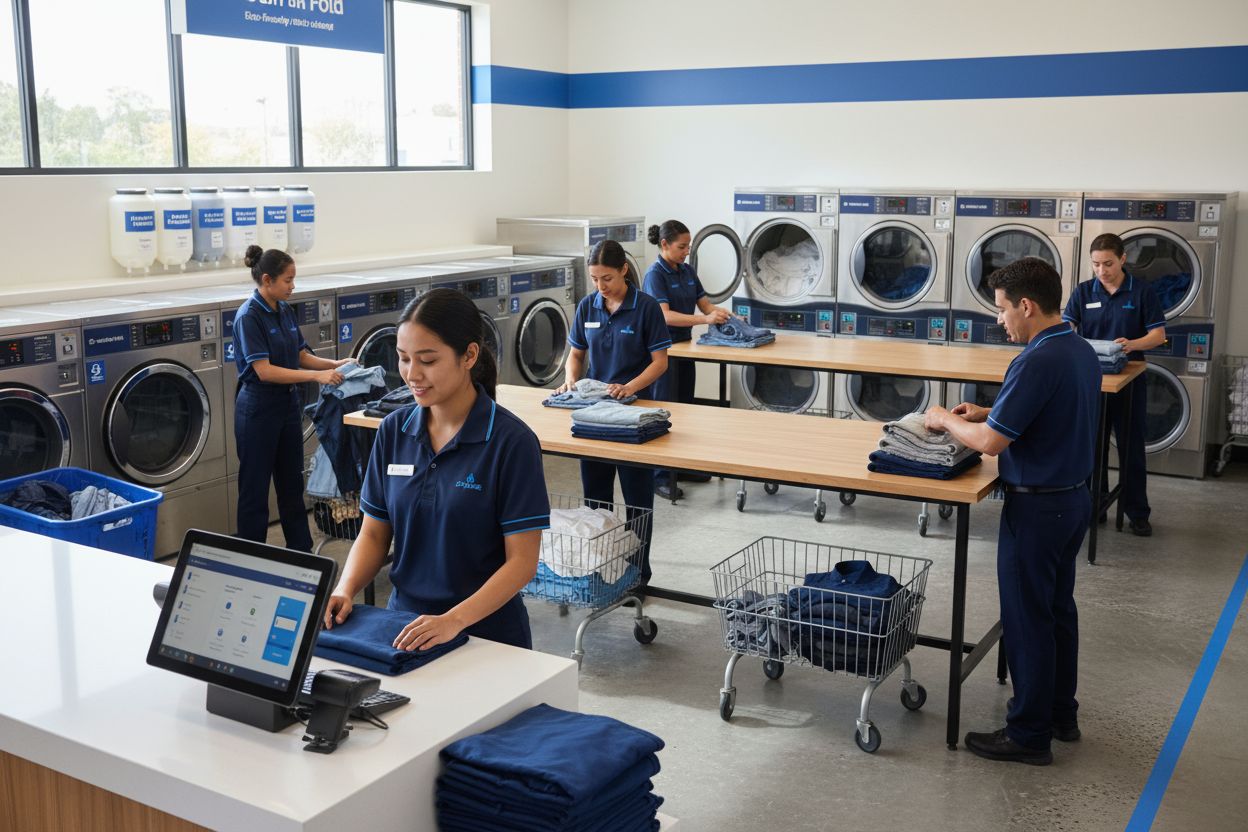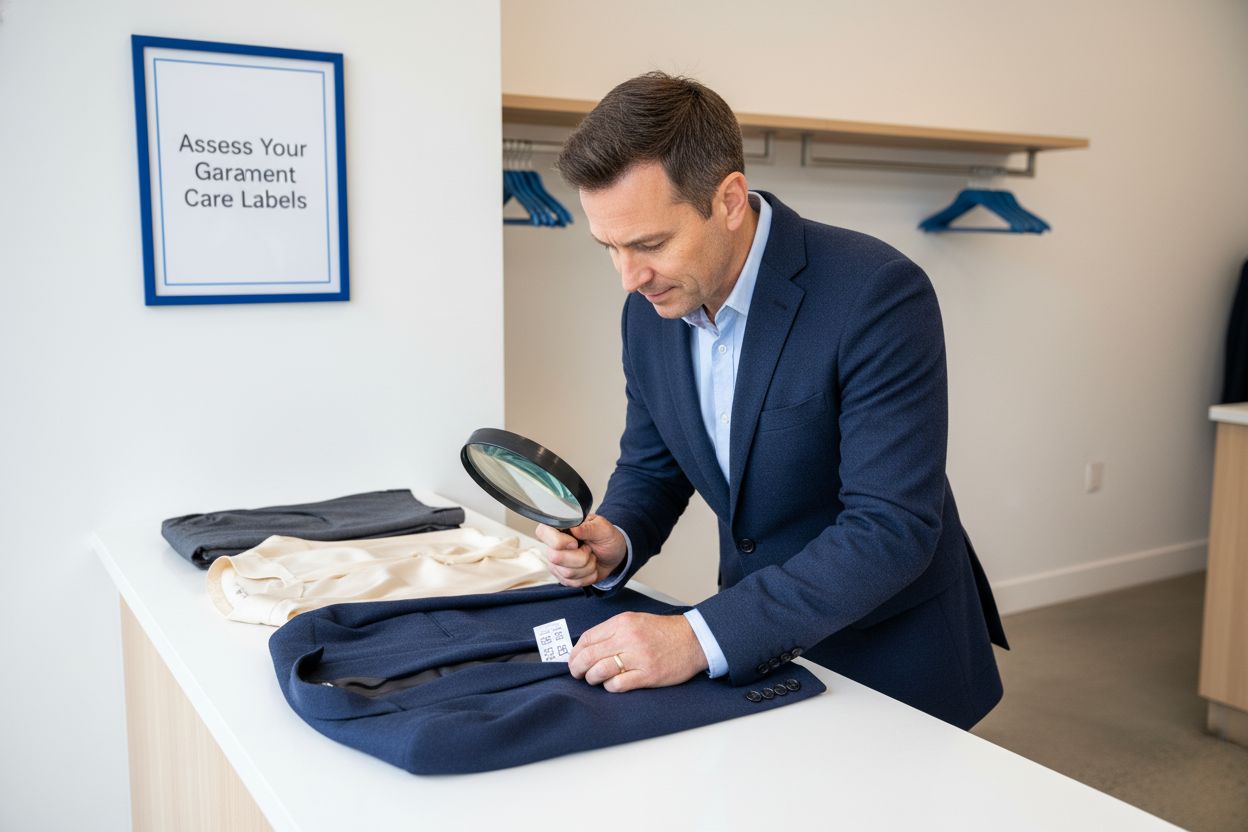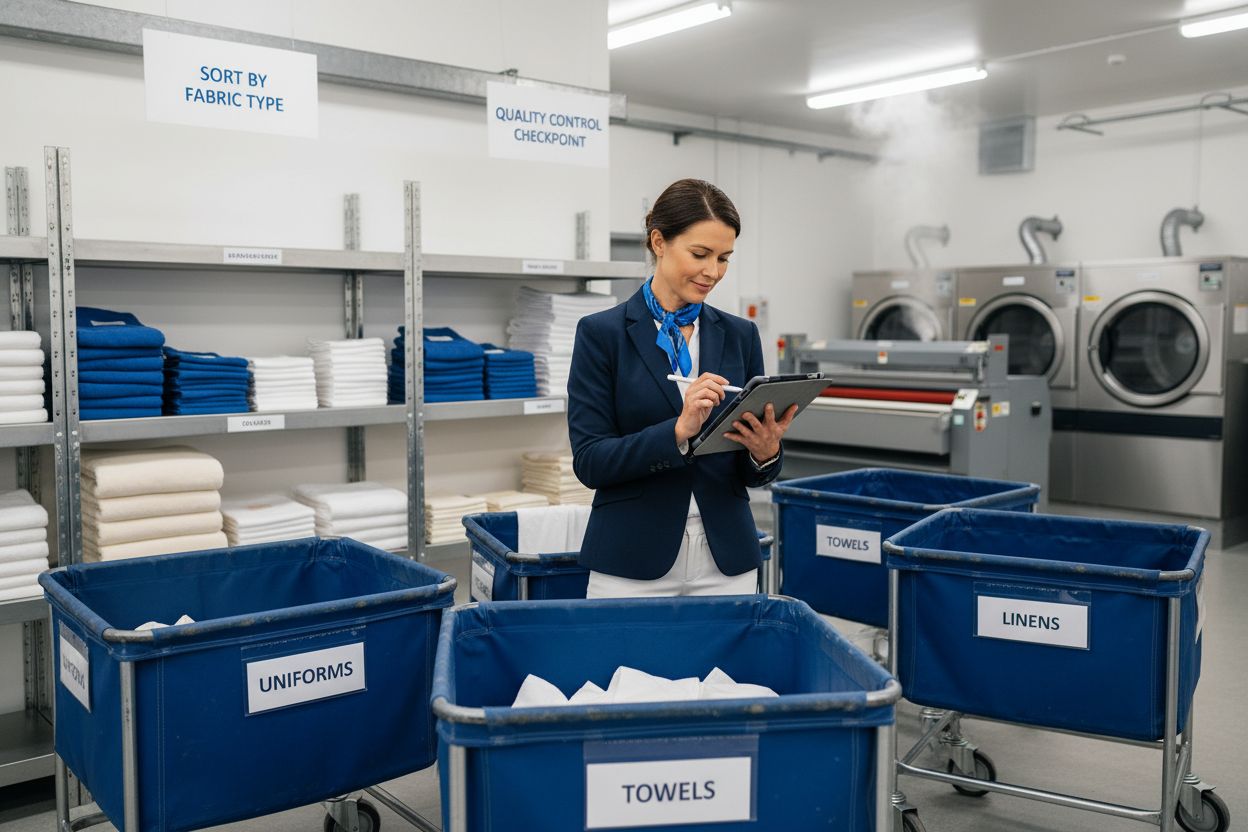Do Laundry Services Separate Colors? (And Why It Matters More Than You Think)

The Wedding Jacket That Turned Pink
"They ruined the jacket my husband wore at our wedding. I sent clear instructions: dry clean only. They washed it instead—with colors. The jacket came back with pink streaks. When I complained, they said it wasn't their fault."
This real customer experience reveals something most people assume every laundry service does: separate darks from lights before washing.
They don't.
And the consequences range from mildly annoying (your white socks now grey) to absolutely devastating (your $500 cashmere sweater now unwearable).
If you've ever wondered whether professional laundry services follow the same basic washing rules your mother taught you, the uncomfortable truth is: many don't. Because separating colors takes time. And time costs money. And when profits matter more than your wardrobe, corners get cut.
But your clothes deserve better.
TakeawayWhat It Means1. Many services don't separate colors—at all.Cost-saving measures lead some companies to wash everything together, risking color bleeding across customers' wardrobes.2. Color bleeding is preventable, not inevitable.Services that properly separate by color, water temperature, and fabric type virtually eliminate this problem.3. "Washing instructions" don't matter if they're ignored.Multiple customers report services ignoring clear "hang dry" or "cold wash only" instructions, causing permanent damage.4. Tech platforms prioritize speed over proper technique.App-based services often use third parties racing against time quotas, leaving no room for careful sorting.5. This is your litmus test for service quality.If they don't separate colors, what other basic standards are they skipping?
Why Color Separation Actually Matters
Let's start with basic laundry science—the kind that hasn't changed in generations.
Different fabrics release different amounts of dye during washing. New dark jeans can release enough indigo to tint an entire load. Red garments are notorious for bleeding onto lighter items. Even "colorfast" items can transfer subtle color over multiple washes with improper sorting.
Water temperature amplifies this effect. Hot water opens fabric fibers, allowing more dye transfer. Cold water keeps fibers tighter, reducing color bleeding risk. This is why your white dress shirts should never share hot water with your dark athletic wear.
Fabric weight matters too. Heavy denim abrading against delicate silk accelerates wear and damage. Towels washed with dress clothes cause pilling through friction. Professional separation considers not just color, but fabric type, weight, and special care requirements.
When laundry services skip proper sorting, they're gambling with your wardrobe. Sometimes you get lucky. Sometimes your white blouse comes back with grey undertones. Sometimes your wedding jacket is permanently ruined.
The frustrating part? This is entirely preventable. It's not complex science—it's basic laundry fundamentals that services skip for operational efficiency.
Understanding fabric care expertise helps you recognize when services are cutting corners on your clothes.
The Industry's Dirty Secret: Speed Over Standards
Here's what customers don't realize is happening behind the scenes at many laundry services.
The Quota Pressure
Third-party processors and gig-economy contractors often work under strict time quotas. Process X pounds per hour, or lose the contract. When you're racing against time targets, sorting by color becomes an expendable step. Everything goes in together because separating takes precious minutes they don't have.
The Bulk Washing Model
Some facilities wash laundry from dozens of customers in shared industrial machines. To make this economically viable, they sort by "lights" and "darks" in the broadest sense possible—if they sort at all. Your burgundy sweater might end up in the "lights" pile because it's "not black." Your light blue shirt might go with "darks" because it's "not white."
The Temperature Shortcuts
Proper separation allows targeted temperature control—cold for colors, warm for whites, hot for sanitizing towels. When everything's mixed, services default to one temperature (usually warm) that minimizes shrinkage risk but maximizes color bleeding.
The "Good Enough" Mentality
From the service's perspective, most customers don't notice minor color transfer. Grey-ish whites still look white-ish. Slightly faded darks still look dark-ish. So if they can process more loads per day by skipping separation, the math favors cutting corners.
One customer put it bluntly: "I've had color bleeding several times. They fix it for free, but still—you were expecting your laundry back and now you have to fill out a form and wait another week for it."
Translation: We know we don't separate properly. We know it causes problems. But it's cheaper to re-wash the occasional complaint than to sort every single order properly.
Your wardrobe shouldn't be a rounding error in someone's efficiency calculation.
See the role professional laundry services should play in properly caring for your investment.
What Actually Happens When Colors Aren't Separated
The damage ranges from subtle to catastrophic, depending on what gets mixed.
Whites Turn Grey or Dingy
This is the most common result. Your crisp white dress shirts gradually lose their brightness, developing that "been washed too many times" look after just a few cycles. Once whites grey, they rarely recover fully even with bleach treatments.
Colors Fade Prematurely
Dark clothes that should last years start looking washed out after months. That vibrant navy blazer takes on a faded blue tint. Your black workout gear turns charcoal grey. Each mixed wash strips more color from the fabric.
Transfer Staining
This is the nightmare scenario. A red sock in with white t-shirts. A bleeding dark jean in with light khakis. One customer's wedding jacket turned pink. Another customer's formal wear got blue streaks. These aren't fixable with re-washing—the damage is permanent.
Accelerated Fabric Wear
Improper sorting means heavy and light fabrics tumbling together, creating friction damage. Delicates abraded by denim develop pilling, thinning, and tears. Your $150 cashmere sweater shouldn't be fighting with your bath towels for survival.
Chemical Reactions
Some detergents and fabric softeners react differently to different colors and fabrics. Mixed loads mean one-size-fits-all chemical treatment, which can yellow whites, dull colors, or damage special finishes like moisture-wicking athletic wear.
Shrinkage from Wrong Temperatures
When services can't use temperature-specific cycles (because the load is mixed), they choose safer middle temperatures. But "safer" often means "not ideal" for any item in the load. Your cotton dress shirts that need hot water don't get truly clean. Your delicates that need cold water risk subtle shrinkage.
The irony? You're paying for professional service that delivers worse results than if you'd just sorted properly and washed at home.
What Proper Color Separation Actually Looks Like
Let's demystify what professional laundry service should do with your clothes.
The Four Basic Categories
At minimum, professional services should separate into:
- Whites: White and off-white items that can handle bleach and hot water
- Lights: Pastels, light greys, khakis that need gentler treatment
- Darks: Navy, black, dark brown items that release dye
- Brights/Reds: Vibrant colors most prone to bleeding
Advanced Sorting Considerations
Better services go further:
- Fabric type: Cotton separated from synthetics from delicates
- Weight: Towels and bedding away from clothing
- Special care: Dry clean only items set aside immediately
- New items: Brand new dark items washed separately first
- Heavily soiled: Work clothes or gym wear pre-treated and separated
Temperature Matching
Each category gets appropriate water temperature:
- Hot water (130°F+): Whites, towels, heavily soiled items
- Warm water (90-110°F): Lights and most everyday colors
- Cold water (80°F or below): Darks, brights, delicates
Cycle Customization
Proper separation allows cycle matching:
- Regular/heavy for durable items
- Permanent press for wrinkle-prone clothing
- Delicate for fine fabrics
- Hand-wash for specialty items
This isn't rocket science. It's the same sorting process you'd do at home—just done consistently, with professional equipment and commercial-grade care.
Learn how proper dry cleaning services work to understand why fabric-specific treatment matters.
How Columbia Pike Laundry Separates Every Single Load
We treat your laundry the way Daniel treats his own family's—with the care it deserves.
Visual Sorting Before Processing
When your order arrives, we don't just dump everything into machines. Daniel or our trained staff visually inspects each item, sorting by color, fabric type, and care requirements. That red shirt goes away from your white blouse. Your wool sweater stays separate from your cotton gym clothes.
Tag-Reading Before Washing
We actually read care labels—every time. If it says "cold wash only," it gets cold water. If it says "dry clean," it doesn't see a washing machine. This sounds basic because it should be, but many services automate past this step entirely.
Multi-Pass Separation
We sort once when receiving your order. We sort again before loading machines. This double-check catches anything that might have been missed initially. Your cashmere sweater won't accidentally end up with the towels because someone was rushing.
Temperature-Specific Loads
We run multiple cycles at different temperatures rather than defaulting to one "safe" medium setting. Your whites get the hot water sanitization they need. Your darks get cold water to prevent fading. Your delicates get gentle cold cycles with reduced agitation.
Customized Folding Preferences
Separation doesn't stop after washing. We keep categories separate during drying and folding so you receive your laundry organized by type—making it easier for you to put away at home.
In-House Quality Control
Because we process everything on-site rather than sending to third parties, quality control stays with us. If someone on our team notices color transfer or damage, they catch it before items leave our facility—not when they arrive at your door.
This is what professional laundry service actually looks like when the company values your wardrobe over processing speed.
See how our complete wash and fold process works to understand the care at every step.
Red Flags That Services Don't Separate Properly
Learn to spot the warning signs before your wedding jacket turns pink.
🚩 Warning Signs:
- Customer reviews mentioning "color bleeding" or "dye transfer"
- No questions about special care items during intake
- Extremely fast turnaround times (under 24 hours typically means rushed sorting)
- Generic "we wash everything together" policies
- Gig-economy drivers who just grab bags without inspecting contents
- No option to specify washing preferences or temperatures
- Services that advertise "one price for everything" (because they wash everything the same way)
- Staff can't explain their sorting process when you ask
- Third-party processing facilities you can't visit or inspect
- Reviews mentioning ignored washing instructions
✅ Green Flags:
- Detailed intake forms asking about color separation preferences
- Staff who inspect your laundry at pickup and ask about special items
- Multiple pricing tiers for different care levels
- In-house processing you can tour
- Specific mentions of color sorting in their service description
- Customer testimonials praising "they actually followed my instructions"
- Temperature options available for different load types
- Clear explanation of their sorting process
- Photos of organized sorting systems in their facility
- Willingness to accommodate custom care requests
Don't wait until you're holding a ruined garment to discover your service doesn't separate properly. Ask during your first conversation—and pay attention to how confident and detailed their answer is.
Questions to Ask Before Trusting Any Service
Protect your wardrobe by knowing exactly what to ask upfront.
1. "Do you separate darks and lights in every load?"
The correct answer is an immediate "yes" with specifics about their sorting categories. Hesitation or vague "we follow best practices" responses are red flags.
2. "What temperature water do you use for different colors?"
If they say "we use warm water for everything," they're not separating properly. Different colors need different temperatures.
3. "Can I specify cold wash only for certain items?"
Services that truly separate should accommodate special requests easily. If they say "everything gets washed the same way," your cashmere is at risk.
4. "How do you prevent color bleeding?"
Look for answers mentioning pre-sorting, temperature control, and separate cycles. Generic "we're careful" doesn't cut it.
5. "What happens if you cause color damage to my clothes?"
Their compensation policy tells you how often this happens. If they have detailed policies, they've dealt with it before.
6. "Do you process laundry in-house or send to third parties?"
Third-party facilities mean less control over sorting standards. In-house processing means accountability.
7. "Can I see your sorting process or tour your facility?"
Transparent services welcome customer visits. Those hiding their process usually have reasons.
8. "How much time do you spend sorting each customer's order?"
Proper sorting takes 5-10 minutes per order. If they process orders in under 2 minutes, they're not sorting thoroughly.
9. "Do you read care labels before washing?"
The only acceptable answer is "yes, every single item." Anything else means automation over inspection.
10. "Have you ever had complaints about color transfer?"
Honest services will admit to occasional issues but explain what they changed afterward. Services that claim "never" are either new or lying.
These questions force services to reveal their actual practices rather than marketing promises. Ask before your first order—not after you're holding pink-streaked white shirts.
The Real Cost of Skipped Color Separation
Color bleeding doesn't just fade clothes—it destroys investments and trust.
Financial Loss
A ruined $300 cashmere sweater, $500 wedding jacket, or $150 designer blouse represents significant money lost. Even if the service "compensates" you with $50 in credits, you're still out hundreds in replacement costs.
Wardrobe Gaps
When key pieces get damaged, you face immediate replacement needs. Your work wardrobe loses essential items. Your exercise gear needs emergency replacement. Your formal attire for upcoming events is suddenly unusable.
Time Wasted on Disputes
Filing claims, providing documentation, waiting for responses, potentially disputing charges—this eats hours of your life for damage that should never have happened.
Loss of Trust
Once a service ruins your clothes through negligence, you'll never trust them fully again. Every pickup creates anxiety. Every delivery requires immediate inspection. The peace of mind you paid for is gone.
Environmental Waste
Prematurely ruined clothing goes to landfills. You buy replacements that weren't necessary. This contributes to fast fashion waste and environmental impact from manufacturing new items.
Emotional Distress
When sentimental items get damaged—your grandmother's sweater, your wedding outfit, your child's first sports jersey—the emotional cost exceeds any financial value. These losses hurt in ways compensation can never fix.
The services that skip separation are essentially gambling with your money, your time, and your peace of mind. Every mixed load is roulette—you might get lucky, or you might not.
Why gamble when you can choose services that do it right every time?
Discover proper fabric care techniques to protect your wardrobe investment long-term.
Why This Matters Beyond Just Laundry
Color separation is a litmus test for service quality across the board.
If a laundry service doesn't bother separating colors—one of the most fundamental washing practices—what other corners are they cutting?
Are they:
- Using proper detergent amounts, or under-dosing to save money?
- Cleaning their machines regularly, or letting residue build up?
- Maintaining equipment properly, or running with worn-out parts?
- Training staff thoroughly, or hiring gig workers with zero textile knowledge?
- Following temperature requirements, or defaulting to "good enough" settings?
Color separation is the canary in the coal mine. It's the visible indicator of invisible standards.
Services that won't invest the extra ten minutes to sort your laundry properly probably won't invest in any of the other quality measures you're assuming they follow. They're optimizing for throughput, not outcomes.
Your clothes deserve a service that sweats the details—even when you can't see them.
Frequently Asked Questions
Q: Should all laundry services separate colors?
Yes. Color separation is a fundamental laundry practice, not an optional premium feature. Any professional service charging professional rates should separate darks, lights, and whites at minimum—with additional fabric-type separation for comprehensive care.
Q: What's the worst that can happen if colors aren't separated?
Permanent color bleeding that ruins garments. One customer had a wedding jacket turn pink. Another lost a $300 cashmere sweater to dye transfer. Your white items can grey permanently. Your dark clothes can fade prematurely. The damage often can't be reversed.
Q: How can I tell if my service actually separates colors?
Ask to see their process or tour their facility. Read reviews specifically mentioning color separation or bleeding. Request they photograph your sorted laundry before washing. Trust services with in-house processing over third-party platforms.
Q: Is it more expensive to use a service that separates properly?
Often there's minimal to no price difference—maybe $0.25-$0.50 per pound more. Compare that to replacing a $200 ruined garment. Proper separation is basic service, not a luxury upgrade.
Q: What should I do if my clothes come back with color damage?
Document damage immediately with photos. Contact the service right away with specific descriptions and values. Request replacement value compensation, not minimal credits. If they refuse adequate compensation, dispute the charge and file BBB complaints. Consider switching services permanently.
Q: Can color bleeding be reversed?
Sometimes minor transfer can be treated with color remover products, but significant bleeding is usually permanent. Prevention through proper separation is far more reliable than attempting repairs after damage.
Q: Should I separate my laundry before pickup?
This shouldn't be necessary with professional services—they should sort properly themselves. However, if your service has unreliable sorting, you can pre-separate and mark bags accordingly. But really, just find a better service.
Q: Do all tech-based laundry apps skip color separation?
Not all, but many platform-based services using gig contractors or third-party processors struggle with proper sorting due to time pressures and lack of training. Local services with in-house staff typically maintain better separation standards.
Q: How long does proper color separation add to processing time?
About 5-10 minutes per customer order for thorough sorting, plus separate wash cycles. This is why some services skip it—to gain processing speed. But proper service is worth the extra time.
Q: Is cold water washing always safer than hot water?
Cold water reduces color bleeding risk but doesn't sanitize as effectively. Proper separation allows temperature matching—hot for whites that need sanitizing, cold for colors prone to bleeding. That's why separation and temperature control work together.
The Bottom Line: Basic Standards Aren't Optional
You're not asking for special treatment when you expect your laundry service to separate colors. You're asking for basic professional competence.
The fact that multiple major laundry services skip this fundamental step reveals how little some companies respect your wardrobe—and your trust.
When Daniel Logan built Columbia Pike Laundry, he started with a simple question: "How would I want my family's laundry handled?" The answer wasn't complex. Separate colors properly. Read care labels. Use appropriate temperatures. Follow basic textile care principles that haven't changed in generations.
These aren't premium features. They're the baseline of professional service.
Your white shirts should stay white. Your darks should stay dark. Your wedding jacket should never, ever turn pink. If a service can't guarantee these basics, they don't deserve your business.
Color separation matters because your clothes matter. They're your professional image. Your comfort. Your financial investment. Your sentimental connections. They deserve to be treated with care, not tossed into mixed loads to maximize someone else's processing speed.
You deserve a service that does laundry the right way—not the fast way.
Ready to experience laundry service that actually separates colors properly? Explore our complete laundry services to see how we handle every fabric type with specialized care. Check our service locations across Northern Virginia to confirm we serve your area. Schedule your first pickup with Columbia Pike Laundry and discover what happens when your laundry service actually follows basic washing principles.
Popular Blog Articles

Meet the Author
Daniel Logan didn’t start CPL because he loved laundry. He started it because his family was drowning in time debt, and laundry was one of the biggest weights.
Mornings were chaos with two kids under 5. Evenings felt like catch-up. And weekends? Gone to sorting socks and folding piles.
He knew his story wasn’t unique. So he built a business that gave families like his just a little bit of breathing room one load at a time.
With no laundry experience but deep tech skills, Daniel rolled up his sleeves, doing every job himself while building systems that turned it into a modern laundry service that saves customers time, simplifies their lives, and delivers reliability they can count on.
That’s where CPL began. Not from a playbook, but from pain. From one dad trying to buy back time: for himself, and for every household like his.








